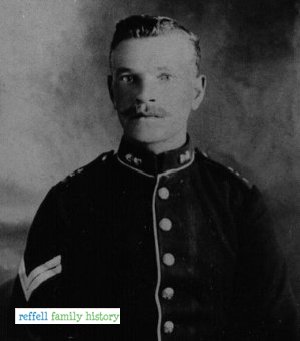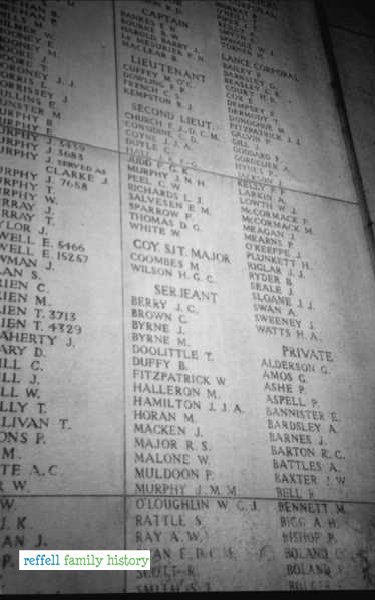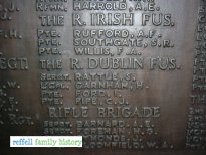2nd Battalion, Royal Dublin Fusiliers
Killed in action on Sunday, 25th April 1915 aged 23

Personal Information:
Samuel was born in Bredfield Street Woodbridge Suffolk on 27 November 1891. The second son of John Rattle (1864-1937) and Sarah Ann Land (1867-1951), he had six brothers and seven sisters. Younger brother James was also in uniform during the war and died prematurely at the age of 46.
Samuel enlisted into the regular army during 1908 at Ipswich and in 1911 he was at the Marlborough Lines in Aldershot Camp, having been promoted to Lance Corporal.
Historical Information:
In 1881, as part of the Cardwell territorial reforms of the British Army, the 102nd (Royal Madras Fusiliers) & 103rd (Royal Bombay Fusiliers) Regiments of Foot became the 1st & 2nd Battalions of the Royal Dublin Fusiliers. Upon the conclusion of the Boer War, the 2nd Battalion returned to the UK and was based in Buttevant, Cork in Ireland. It left for Aldershot England in 1910, receiving its new Colours from the Regiment’s Colonel-in-Chief the following year.
During World War 1, a total of 11 Battalions were raised from its peacetime complement of two regular and three reserve Battalions. The 2nd Dublins arrived in France in the month war was declared as part of the British Expeditionary Force (BEF), the professionals of the old regular army known as the ‘Old Contemptibles’ after a comment made by the German Kaiser. The 2nd Dublins took part in the retreat from Mons, taking part in their first engagement on 26 August 1914 at Le Cateau that helped delay the German advance towards Paris, inflicting such heavy casualties that the Germans thought they faced more machine-guns than they actually did. The BEF then resumed their retreat, but many including from the Dublin Fusiliers, were stranded behind German lines and many were taken prisoner by the Germans. The Battalion was badly depleted but later took part in the Battle of the Marne (5-9 September) that finally halted the German advance just on the outskirts of Paris, forcing the Germans to retreat to the Aisne.
The 2nd Dublins took part in the Battle of the Aisne and later took part in their last major engagement of the war at the Battle of Armentières, which began on 13 October and ended on 2 November. The 2nd Dublins took part in all but one of the subsidiary battles during Second Ypres between 22 April-24 May 1915. The Battalion suffered heavily at the Battle of St Julien, the second subsidiary battle, incurring hundreds of casualties including Samuel. They had no respite, taking part in the next two subsidiary battles at Frezenburg and Bellewaarde, but on 24 May the Battalion was subject to a German poison gas attack near Saint-Julien and effectively disintegrated as a fighting unit.
The Battalion did not take part in any more major battles for the rest of the year. After the war in 1922 upon the creation of the Irish Free State, the six Irish infantry regiments, including the Royal Dublin Fusiliers, were disbanded.
Historical Information: War Diary of 2nd Battalion Dublin Fusiliers – April 1915.
Attack on St. Julien: Battalion deployed west of the Wieltje – St. Julien Road 4am. 7am. Lt. Col Loveband CMG being wounded handed over command to Capt. Banks. Battalion dug in on a line a ¼ mile from and facing St. Julien. Heavy casualties. Quiet night.
Extract from “Crown & Company – The Records of the 2nd Battalion, Royal Dublin Fusiliers – Vol II 1911-1922” by Col. H C Wally C.B.
On April 23rd, the 2nd Battalion Royal Dublin Fusiliers was ordered to be ready to move at half an hour’s notice, and accordingly it left Bailleul at 7.30 that evening, marching north, billeted that night at Westoutre, and, leaving early again on the 24th, moved by Hensken, Zevecoten, Ouderdom, and Vlamertinghe to the outskirts of Ypres, which were reached at 8 p.m. At Ypres packs were discarded, and at midnight the Battalion marched on St. Jean, deploying at 4 a.m. on the 25th west of the Wieltje St. Julien road. The need that had arisen to call for the 10th Brigade to take hurriedly its part in what is known as the Second Battle of Ypres, was due to the success which had been won by the Germans in their attack on the 22nd upon the position held by the Canadians and the French between Bixschoote and Langemarck, owing to their unexpected employment of gas, resulting in the forcing of a gap five miles wide in the front of the Allied position. It was a desperately difficult undertaking, the night was extremely dark, the ground, which had not been reconnoitred, was honeycombed with trenches and strewn with barbed wire, and, moreover, the artillery had not been able to ‘register’ that is to say, get its range of the terrain.
Just before the attack was launched word came back that some Canadians were still holding out in the village of St. Julien,” whence a fresh gas attack had driven the Canadian left on the morning of the 24th. ” Therefore the place could not be shelled. The guns, however, opened on the wood west of the village. The 7th Argyll and Sutherland Highlanders, a Territorial battalion that was on its trial that day, led with splendid dash on the right, the 1st Warwicks on the left. They were followed on right and left respectively by the 1st Royal Irish Fusiliers and the 2nd Dublins, while the 2nd Seaforths were ordered to connect with General Riddell’s brigade of the Northumberland Division, which had been sent up to relieve the Canadians. As soon as our men got out of their trenches they were met by a terrific machine gun and rifle fire at close quarters, whilst the German heavy guns in the rear spouted a continual torrent of shells over the fields through which the assault was delivered. Our men dropped left and right, but they never wavered, and the Irish Fusiliers and the Dublins, Irishmen all, fighting shoulder to shoulder, actually got into the outskirts of St. Julien.” The scattered ruins, the maze of trenches, and the barbed wire strung out everywhere, seriously delayed these two battalions and checked our advance.
Two battalions of a brigade of the Northumberland Division, supporting the Dublins, lost their direction. . . . On the left the Warwicks and on the other flank the Highlanders got to within 70 yards of the German trenches in front of the wood. Here they were hung up and were ‘ properly hammered,’ in the words of one who was there, by German high explosive shells. Nevertheless, by this gallant attack the gap between the Canadians east of St. Julien and north of Fortuin was filled.” At the close of the first day’s fighting Lieutenant Colonel Loveband was wounded, and handed over command of the Battalion to Captain Bankes, and the Royal Dublin Fusiliers dug themselves in on a line facing, and a quarter of a mile from St. Julien.”

Memorials:
1) Panel 44 and 46 Menin Gate Memorial, leper, West Vlaanderen, Belgium
The Menin Gate was unveiled on 27 July 1927 and is possibly the best known of all the Commonwealth War Graves Commission’s memorials. It weighs over 20,000 tonnes and carries 54,000 names of men who died in the Flanders area up to 15 August 1917, and who have no known grave.

2) Ipswich War Memorial, Christchurch Park, Suffolk, England
The Ipswich War Memorial is located in Christchurch Park and was unveiled in March 1924 to commemorate those of the town who died in the First World War.